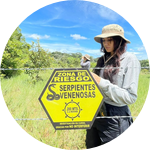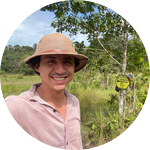About This Project
Bothrops atrox, a Crotalinae subfamily viper, has loreal pits sensitive to infrared radiation. Recently, a structure termed papillae was described, which could potentially be linked to thermoreception. This study aims to investigate the thermoreceptive function of papillae through field experiments, comparing responses to thermal stimuli under different sensory conditions. This results will contribute to the development of conservation strategies and tools for snakebite prevention.
Ask the Scientists
Join The DiscussionWhat is the context of this research?
The venomous snakes's Crotalinae subfamily is characterized by the presence of loreal pits (Goris, 2011), specialized organs sensitive to infrared radiation that detect fluctuations in temperature (Bullock & Diecke, 1956). This information is integrated with that from other sensory systems to detect and respond to defensive (Roelke & Childress, 2007) and hunting (de Cock Buning, 1983) scenarios. Recently, researchers described a structure called papillae, whose function likely contributes to thermoreception. Located at the anterior corner of the eye, and despite lacking nerve endings, they communicate with the loreal pit and thermoreceptive membrane via an internal conduit (Bolívar-G et al., 2014). However, further studies are needed to fully understand their function.
What is the significance of this project?
Latin America is recognized as one of the regions with the highest risk of snakebites. However, there's a noticeable gap in research on the behavioral biology and sensory ecology of venomous snakes. Bothrops atrox, responsible for the majority of envenomations where it is distributed (Sevilla-Sanchez et al., 2021), underscores the importance of understanding how these snakes perceive and react to their surroundings. By unraveling their sensory functions and responses to thermal cues we can deepen our understanding of their sensory ecology, which, in turn, can guide the development of preventive measures to reduce snakebite risks and support conservation efforts.
What are the goals of the project?
The aim of this study is to assess the potential thermoreceptive function of the papillae in the species Bothrops atrox, as well as to examine responses to thermal stimuli under various sensory conditions. We expect that the results obtained will contribute to expanding the understanding of the sensory ecology of this species further develop specific preventive and intervention strategies to mitigate risks and address the human-snake problem more effectively.
Budget
These items, ranging from research materials to software tools, equipment and traveling expenses, will provide us with the necessary resources and support required for conducting experiments on the field, gathering data, and analyzing results effectively. We want to ensure that our project progresses smoothly, enabling us to achieve our research objectives efficiently and generate valuable insights or contributions to our field of study.
Endorsed by
 Project Timeline
Project Timeline
The schedule for this study involves four key steps. First, we'll set up our experiments by building the structure to hold and move the stimulus and programming the motor for the movement. Next, we'll standardize the application of the obstructions for the experiments. Once this is done, we'll head out into the field to find the individuals and run the experiments. For the final step, we'll analyze all the data we've gathered and publish our findings.
May 15, 2024
Project Launched
Sep 02, 2024
Build the Experimental Arena: Construct the arena for conducting experiments.
Sep 16, 2024
Program Motor Movement: Set up the motor for moving stimuli within the arena.
Oct 01, 2024
Standardize Obstructor Application with from collection for teaching purposes.
Oct 13, 2024
Fieldwork - Finding 10 Individuals: Spend two weeks in the field locating and capturing 10 individuals.
Meet the Team
Affiliates
Affiliates
Affiliates
Affiliates
Team Bio
We are an interdisciplinary team dedicated to gaining a comprehensive understanding of snake biology and behavior in Colombia, with a strong emphasis on developing strategies for both prevention and conservation to mitigate the risk of snakebites. Through collaborative research efforts, we aim to develop tools that allow us to improve the relationship between communities and snakes, based on the understanding of their biology.
Sophia Bohorquez
Sophia completed her undergraduate studies at the University of Los Andes and is currently pursuing a master's degree at the same institution. Her research is centered around venomous snakes, investigating their physiology and behavior. Driven by a deep passion for herpetofauna, she aims to make meaningful contributions to the understanding and conservation of these animals in Colombia.
Carlos Bravo Vega
Carlos is a Chemical engineer who holds a master's degree in biomedical engineering and a PhD in engineering from the University of Los Andes. His main interest lies in eco-epidemiology, focusing on understanding how wildlife and humans interact. He's particularly concerned about snakebite, a disease that affects many people in Colombia, especially those in rural and poor areas. Carlos is dedicated to finding ways to prevent snakebites and improve the lives of vulnerable communities.
Currently, Carlos works as a professor in the Biomedical Engineering Department at the University of Los Andes, and he is member of the Grupo de Investigación en Biología Matemática y Computacional BIOMAC. He collaborates with organizations like the Clodomiro Picado Institute in Costa Rica and the Fundacion Herpetologica Gustavo Orces in Ecuador on projects related to venomous snakes and snakebite prevention. Through his work, Carlos aims to improve our understanding of eco-epidemiology and develop practical ways to reduce the harm caused by snakebites.
Jorge Eliecer Garcia Guzman
Jorge García, a Colombian cowboy, has spent his entire life working in the countryside across various agricultural and livestock systems. For the past 16 years, he has been working at the Rey Zamuro - Matarredonda Natural Reserve, where his primary role is to oversee sustainable livestock production. In recent years, he developed a keen interest in local snakes and has become a self-taught local expert on the subject. Since 2022, he has been collaborating as a co-investigator on projects related to these animals, leading the field phases involving the search and collection of in-situ data on the Bothrops atrox snake in Rey Zamuro.
Diego A. Gómez Sánchez
With over 15 years of field experience studying snakes, Diego has recently shifted his focus towards conservation projects through bilateral learning with communities, training on snakebite accidents, collaborative research, and scientific tourism. Collaborations from Rey Zamuro are spearheading pioneering snake research initiatives in Colombia, including this one.
Jorge Molina
Jorge is a biologist with a master degree in biological sciences from Universidad de los Andes in Bogota. After finishing his studies in Colombia, Jorge obtained a Dr. rer. nat. in neurophysiology from the University of Göttingen in Germany. Before returning to Colombia, Jorge did a postdoc working for two years with vibratory receptors in spiders at the University of Vienna.
Jorge's main interest is sensory ecology or how animals use their sensory systems to interact with each other, with other species and/or with their environment.
Currently, Jorge is a Full Professor in the Department of Biological Sciences at the Universidad de los Andes in Bogota.
With this project Jorge hopes to apply basic science in snakes sensory ecology to reduce dangerous exposure to snake bites in Colombia.
Lab Notes
Nothing posted yet.
Project Backers
- 0Backers
- 0%Funded
- $0Total Donations
- $0Average Donation





